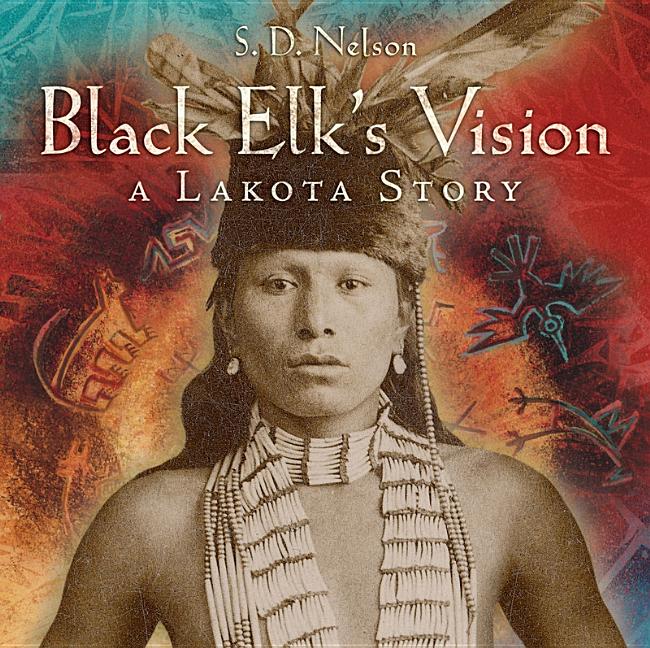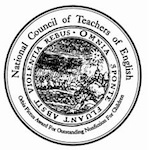
Book Resume
for Black Elk's Vision: A Lakota Story by S.D. Nelson
Professional book information and credentials for Black Elk's Vision.
5 Professional Reviews (2 Starred)
4 Book Awards
Selected for 7 State/Province Lists
See full Book Resume
on TeachingBooks
An account of the life of Black Elk, the Lakota-Oglala medicine man, is based largely ...read more
- School Library Journal:
- Grades 3 - 6
- Booklist:
- Grades 5 - 8
- Publisher's Weekly:
- Ages 8 - 12
- TeachingBooks:*
- Grades 3-8
- Word Count:
- 4,444
- Lexile Level:
- 770L
- ATOS Reading Level:
- 5
- Cultural Experience:
- American Indian
- Genre:
- Biography
- Nonfiction
- Picture Book
- Year Published:
- 2010
9 Subject Headings
The following 9 subject headings were determined by the U.S. Library of Congress and the Book Industry Study Group (BISAC) to reveal themes from the content of this book (Black Elk's Vision).
- Juvenile Nonfiction | Biography & Autobiography | Historical
- Oglala Indians--Biography--Juvenile literature
- Oglala Indians--Biography
- Children's Books/Ages 9-12 Fiction
- Black Elk, 1863-1950
- Oglala Indians
- Black Elk
- Black Elk, 1863-1950--Juvenile literature
- Juvenile Nonfiction | People & Places | United States - Native American
5 Full Professional Reviews (2 Starred)
The following unabridged reviews are made available under license from their respective rights holders and publishers. Reviews may be used for educational purposes consistent with the fair use doctrine in your jurisdiction, and may not be reproduced or repurposed without permission from the rights holders.
Note: This section may include reviews for related titles (e.g., same author, series, or related edition).
From Cooperative Children's Book Center (CCBC)
An account of the life of Black Elk, the Lakota-Oglala medicine man, is based largely (but not wholly) on Black Elk Speaks and strikingly illustrated by artist S. D. Nelson. Born in 1863, Black Elk’s Great Vision came to him when he was nine years old. As he grew into adulthood he became known in his community as someone who could heal others through his connection to the Spirit World. Black Elk fought in the Battle of Little Big Horn, saw the slaughter of the buffalo that were so important to Lakota survival, and witnessed the Wounded Knee massacre. He worked in Buffalo Bill’s Wild West show, a stereotypical production in which Indians pretended to die at the hands of cowboys, in part to try to learn about the Wha-shi-choo (“Wasichu” in Lakota, meaning white man). Throughout his life, he held fast to his vision, which affirmed the circle of life, of support and respect. S. D. Nelson’s stunning artwork offers an expressive, cohesive visual accompaniment to the narrative, which is also enhanced by archival black-and-white photographs. A timeline, source notes, and other material round out the volume. (Ages 9–13)
CCBC Choices 2011 © Cooperative Children's Book Center, Univ. of Wisconsin - Madison, 2011. Used with permission.
From Horn Book
July 1, 2010
Lakota Black Elk fought in the 1876 Battle of the Little Big Horn at twelve years old, was shot at Wounded Knee, and performed in Buffalo Bill's Wild West Show. Using archival material, Sioux author-artist Nelson offers a first-person account of Black Elk's life. Captioned black-and-white photographs and extensive notes provide historical context and critique the exploitation of Native American tribes. Timeline. Bib., ind.
(Copyright 2010 by The Horn Book, Incorporated, Boston. All rights reserved.)
From School Library Journal
Starred review from April 1, 2010
Gr 3-6-Born in 1863, Black Elk, an Oglala-Lakota medicine man, was warned from an early age to beware the "Wha-shi-choo," or white people, and for good reason. By the time he was 16, his people had been attacked on their lands, fought at the Battle of the Little Bighorn, and been confined to grim reservations, their way of life forever changed. Told in a first-person narrative, this handsome biography is adorned with vibrant acrylic paintings that depict the mystical images (spirit voices and visions) that Black Elk first experienced as a child. A fever vision at age nine, in which he met with the six grandfathers, the ancestral beings, proved to be a pivotal experience for him. As a teenager, he ultimately led a Horse Dance ceremony in which he brought a message of hope and instruction to his people. In addition to his respected tribal status, his involvement in many landmark events, from his travels with Buffalo Bill's Wild West Show to being injured at the Wounded Knee massacre, makes him a unique historical figure. Aptly chosen photographs (some of which are graphic images of buffalo carcasses and a scene of a mass grave at Wounded Knee) provide accurate historical perspective. An author's note on understanding his Great Vision and background information on the book are included. This is an important contribution to Native biography."Madeline J. Bryant, Los Angeles Public Library"
Copyright 2010 School Library Journal, LLC Used with permission.
From Booklist
Starred review from March 15, 2010
Grades 5-8 *Starred Review* This handsomely designed, large-format book tells the story of Black Elk (18631950), a Lakota man who saw many changes come to his people. In this first-person, present-tense account, Black Elk says that as a nine-year-old boy, he is blessed with a Great Vision. At 12, he fights in the Battle of Little Bighorn. After traveling in Europe with Buffalo Bills Wild West show and, later, experiencing the massacre at Wounded Knee, he retreats to a reservation, where he holds his vision in his heart and offers it to others. Often quoting from Black Elk Speaks (1932), Nelson makes vivid the painful ways life changed for the Lakota in the 1800s, and throughout he questions how Black Elks vision, which explains that humans must realize they are living in a circle of supportive life, juxtaposes against harsh reality. It is a question readers will ponder as well. Colorful, imaginative artwork, created using pencils and acrylic paints, is interspersed with nineteenth-century photos, underscoring that this dramatic account reflects the experiences of a man who witnessed history. Back matter includes an extensive authors note, a detailed time line, source notes, and a source bibliography. A helpful, attractive map on the endpapers frames this unusual presentation.(Reprinted with permission of Booklist, copyright 2010, American Library Association.)
From Publisher's Weekly
February 15, 2010
Nelson (Coyote Christmas
) returns with his highly stylized paintings and trademark primary-colored horses in this tale about Black Elk, a Sioux medicine man at the turn of the 19th century. The author, a member of the Standing Rock Sioux tribe, imagines Black Elk's first-person account of Native American life as the Wha-shi-choos (white people) bring trains and forts to the Great Plains and slaughter buffalo by the thousands (“They made lines on our land with their wagon roads and their iron rails”). Anchoring the story are spreads detailing Black Elk's vision when he was nine. In it, “the Powers of the World” teach that each person “must choose to walk with the water of life or the weapon of destruction.” The illustrations' naïve, flat style mutes some of the more graphic events (speared and bloodied fighters and horses are seen at the Battle of the Little Bighorn). Archival photos round out this poignant history lesson, and author notes contextualize the meaning of Black Elk's vision within Native philosophy. A time line of European exploration and western settlement and select Indian War conflicts is included. Ages 8–12.
4 Book Awards & Distinctions
Black Elk's Vision was recognized by committees of professional librarians and educators for the following book awards and distinctions.
7 Selections for State & Provincial Recommended Reading Lists
Black Elk's Vision was selected by educational and library professionals to be included on the following state/provincial reading lists.
United States Lists (7)
California
Minnesota
- American Indian Academic Standards Book List: 4-6
- American Indian Academic Standards Book List: K-3
- Anishinabe, Dakota & Lakota: Elementary Books
Oklahoma
- 2013 Sequoyah Book Awards -- Children's
South Dakota
- Prairie Pasque Award, 2012-2013, Grades 3-5
Texas
- 2011-2012 Bluebonnet Award Nominees
Primary Source Statement on Creating Black Elk's Vision
S.D. Nelson on creating Black Elk's Vision:
This primary source recording with S.D. Nelson was created to provide readers insights directly from the book's creator into the backstory and making of this book.
Listen to this recording on TeachingBooks
Citation: Nelson, S.D.. "Meet-the-Author Recording | Black Elk's Vision." TeachingBooks, https://school.teachingbooks.net/bookResume/t/17705. Accessed 02 February, 2025.
This Book Resume for Black Elk's Vision is compiled from TeachingBooks, a library of professional resources about children's and young adult books. This page may be shared for educational purposes and must include copyright information. Reviews are made available under license from their respective rights holders and publishers.
*Grade levels are determined by certified librarians utilizing editorial reviews and additional materials. Relevant age ranges vary depending on the learner, the setting, and the intended purpose of a book.
Retrieved from TeachingBooks on February 01, 2025. © 2001-2025 TeachingBooks.net, LLC. All rights reserved by rights holders.


 ALSC Notable Children's Books, 1995-2025, Commended, 2011
ALSC Notable Children's Books, 1995-2025, Commended, 2011
 CCBC Choices, Selection, 2011
CCBC Choices, Selection, 2011
 Orbis Pictus Award, 2000-2025, Commended, 2011
Orbis Pictus Award, 2000-2025, Commended, 2011
 Lasting Connections, 2000 - 2020, Selection, 2010
Lasting Connections, 2000 - 2020, Selection, 2010
